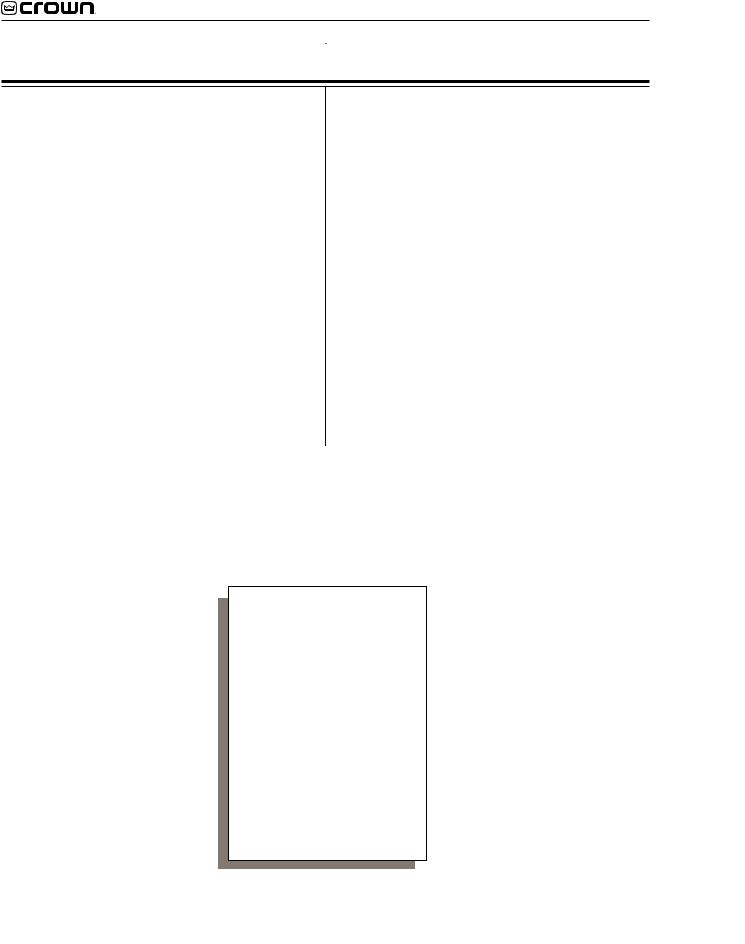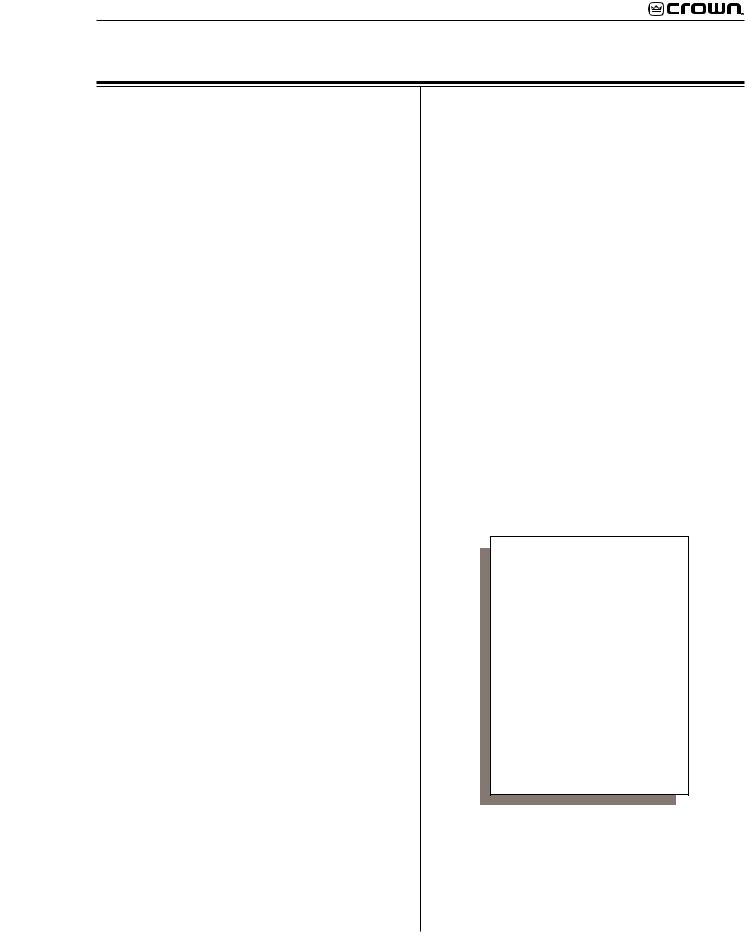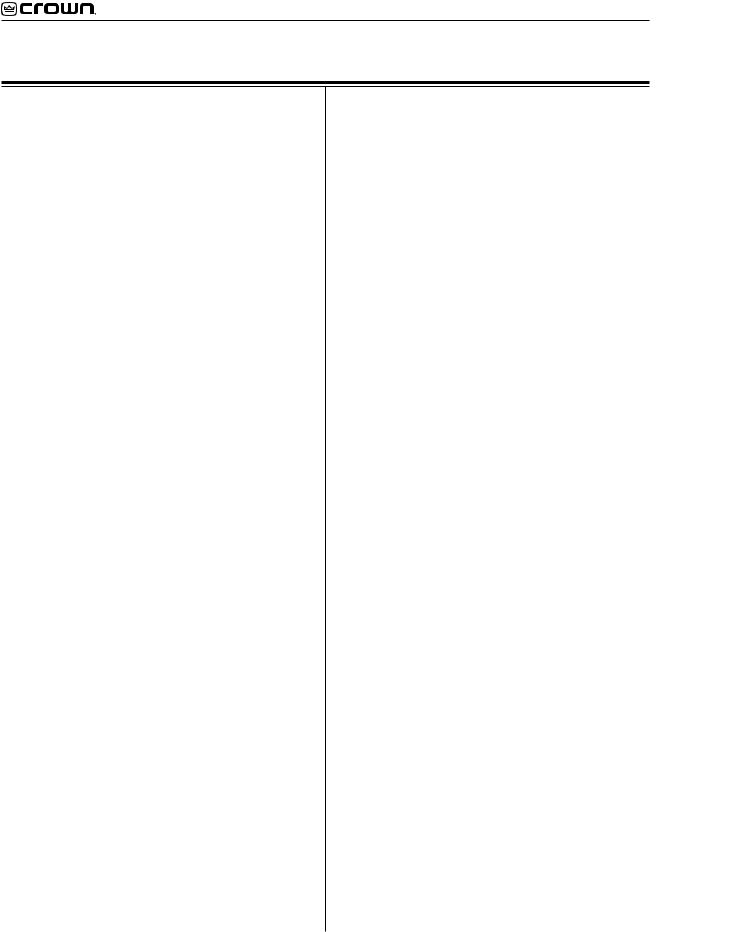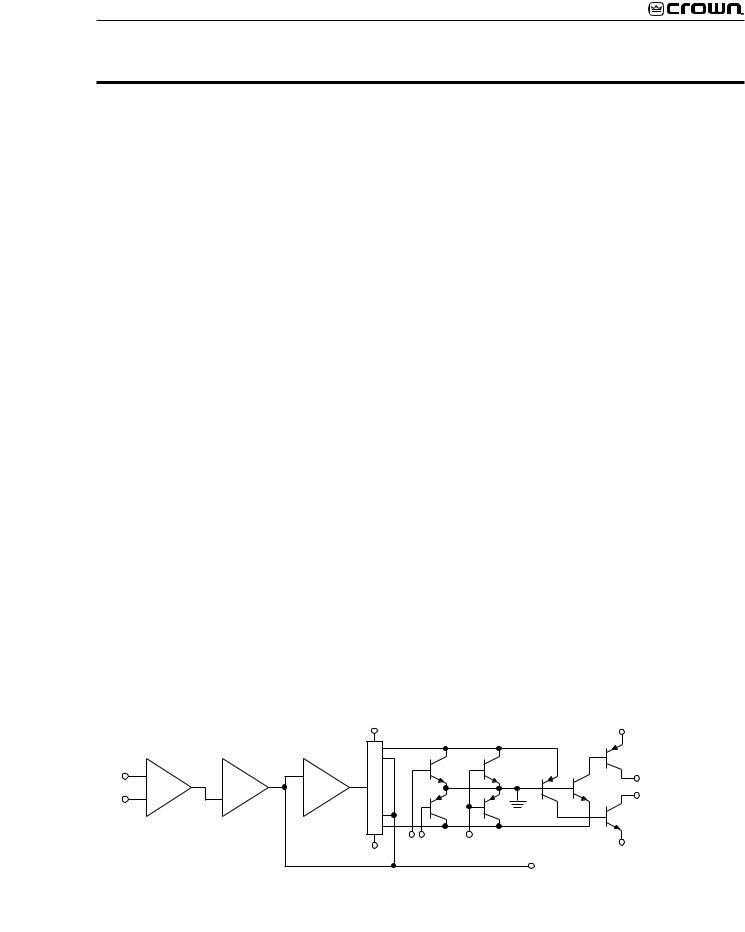Crown Audio 2400 User Manual

Micro-Tech 2400 Amplifier Service Manual
POWER AMPLIFIER
SERVICE MANUAL
MICRO-TECH®-2400
©1995 by CROWN INTERNATIONAL, INC.
Mailing Address: |
Shipping Address: |
P.O. Box 1000 |
57620 C.R. 105 |
Elkhart, IN U.S.A. 46515-1000 |
Elkhart, IN U.S.A. 46517 |
Micro-Tech®, ODEP® and Crown® are registered trademarks of Crown International, Inc.
K-SVCMT24 7-95
1

Micro-Tech 2400 Amplifier Service Manual
The information furnished in this manual does not include all of the details of design, production, or variations of the equipment. Nor does it cover every possible situation which may arise during installation, operation or maintenance. If you need special assistance beyond the scope of this manual, please contact the Crown Technical Support Group.
Mail: P.O. Box 1000 Elkhart IN 46515-1000
Shipping: 57620 C.R. 105 Elkhart IN 46517
Phone: (800) 342-6939/(219) 294-8200
FAX: (219) 294-8301
|
|
|
|
|
|
|
CAUTION |
|
|
AVIS |
|
|
|
|
|
|
|
TO PREVENT ELECTRIC SHOCK DO |
|
|
|
||
NOT REMOVE TOP OR BOTTOM |
À PRÉVENIR LE CHOC |
||||
COVERS. NO USER SERVICEABLE |
ÉLECTRIQUE N’ENLEVEZ |
||||
PARTS INSIDE. REFER SERVICING |
PAS LES COUVERTURES. |
||||
TO QUALIFIED SERVICE |
|
RIEN DES PARTIES |
|||
PERSONNEL. DISCONNECT |
UTILES À L’INTÉRIEUR. |
||||
POWER CORD BEFORE REMOVING |
DÉBRANCHER LA BORNE |
||||
REAR INPUT MODULE TO ACCESS |
AVANT D’OUVRIR LA |
||||
|
GAIN SWITCH. |
MODULE EN ARRIÈRE. |
|||
|
|
|
|
|
|
WARNING
TO REDUCE THE RISK OF ELECTRIC
SHOCK, DO NOT EXPOSE THIS
EQUIPMENT TO RAIN OR MOISTURE!
2

Micro-Tech 2400 Amplifier Service Manual |
|
Table of Contents |
|
Introduction ............................................................. |
4 |
Scope ...................................................................... |
4 |
Warranty .................................................................. |
4 |
Parts Information ..................................................... |
5 |
Specifications .......................................................... |
6 |
Voltage Conversion ................................................. |
7 |
Circuit Theory .......................................................... |
8 |
Electrical Checkout Procedures ............................ |
13 |
Parts List (Non-Module) ........................................ |
16 |
Module Information ............................................... |
19 |
M46330-3 Fuse Module ........................................ |
20 |
Q43327-8 Display Module .................................... |
20 |
Q43354-2 Output Module ..................................... |
21 |
Q43328-6 Main Module ......................................... |
22 |
Q43399-7 Main Module ......................................... |
26 |
3

Micro-Tech 2400 Amplifier Service Manual
Introduction
This manual contains service information on Crown power amplifiers. It is designed to be used in conjunction with the applicable Owner's Manual. However, some important information is duplicated in this Service Manual in case the Owner's Manual is not readily available.
NOTE: THE INFORMATION IN THIS MANUAL IS INTENDED FOR USE BY AN EXPERIENCED TECHNICIAN ONLY!
SCOPE
This Service Manual includes several sections. These sections include Parts Information, Specifications, Voltage Conversion, Circuit Theory, Electrical Test Procedures, Non-Module Parts Lists, and Module Parts Lists. Schematics are attached. Note that component parts with circuit board comprise a complete module. Module part numbers are always associated with a specific circuit board, although an unpopulated circuit board may be built up with different parts to create different modules. Note that Crown does not sell blank (unpopulated) circuit boards.
Each of the compact audio power amplifiers are designed for professional or commercial use. Providing high power amplification from 20Hz to 20KHz with minimum distortion, they feature balanced inputs with bridged and parallel monophonic capability. Specific features vary depending on model family.
WARRANTY
Each Owner's Manual contains basic policies as related to the customer. In addition it should be stated that this service documentation is meant to be used only by properly trained service personnel. Because most Crown products carry a 3 Year Full Warranty (including round trip shipping within the United States), all warranty service should be referred to the Crown Factory or Authorized Warranty Service Center. See the applicable Owner’s Manual for warranty details. To find the location of the nearest Authorized Service Center or obtain instructions for receiving Crown Factory Service please contact the Crown Technical Support Group (within North America) or your Crown/ Amcron Importer (outside North America).
Crown
Technical Support Group
Factory Service
Parts Department
Mailing Address:
PO Box 1000
Elkhart, IN USA 46515-1000
Shipping Address:
57620 C.R. 105
Elkhart, IN USA 46517
Phone: (219) 294-8200
Toll Free: (800) 342-6939
FAX: (219) 294-8301
4

Micro-Tech 2400 Amplifier Service Manual
Parts Information
GENERAL INFORMATION
Later sections include both mechanical and electrical parts lists for this product. The parts listed are current as of the date printed. Crown reserves the right to modify and improve its products for the benefit of its customers.
PART NUMBERING SYSTEMS
As of the printing of this manual, Crown is using two numbering systems. The elder system always uses eight characters. The first character is a letter. Common letters used are C, D, H, M, P, and Q. The second through sixth characters are numbers. The numbers build sequentially (for each prefix letter) as new parts are added to our parts inventory system. (In some cases there will be a space then a four character number after the prefix letter; the space is considered a character.) The seventh character is usually a hyphen, though it may be a letter to indicate a revision or special note. The last character is called a check-digit, and is useful to Crown for internal tracking.
Crown is in the process of converting to a new part number system. Length may vary from eight to twelve characters. There is still a letter prefix, then five numbers. These five numbers identify a type of part. The seventh character is a hyphen. Remaining characters identify the details of the type of part identified by the first part of the number.
STANDARD AND SPECIAL PARTS
Many smaller electrical and electronic parts used by Crown are stocked by and available from electronic supply houses. However, some electronic parts that appear to be standard are actually special. A part ordered from Crown will assure an acceptable replacement. Structural items such as modules and panels are available from Crown only.
ORDERING PARTS
When ordering parts, be sure to give the product model, and include a description and part number (CPN/DPN) from the parts listing. Price quotes are available on request.
SHIPMENT
Shipment will be normally made by UPS or best other method unless you specify otherwise. Shipments are made to and from Elkhart, Indiana USA, only. Established accounts with Crown will receive shipment freight prepaid and will be billed. All others will receive
shipment on a C.O.D. or pre-payment (check or credit card) basis.
TERMS
Normal terms are pre-paid. Net-30 Days applies to only those firms having pre-established accounts with Crown. If pre-paying, the order must be packed and weighed before a total bill can be established, after which an amount due will be issued and shipment made upon receipt of pre-payment. New parts returned for credit are subject to a 10% re-stocking fee, and authorization from the Crown Parts Department must be obtained before returning parts for credit.
Crown is not a general parts warehouse. Parts sold by the Crown Parts Department are solely for servicing Crown/Amcron products. Part prices and availability are subject to change without notice.
Crown
Parts Department
Mailing Address:
PO Box 1000
Elkhart, IN USA 46515-1000
Shipping Address:
57620 C.R. 105
Elkhart, IN USA 46517
Phone: (219) 294-8210
or: (219) 294-8211
Toll Free: (800) 342-6939
FAX: (219) 294-8301
5

Micro-Tech 2400 Amplifier Service Manual
Specifications
Unless noted otherwise, all specifications are based on driving an 8 ohm load per channel, both channels driven, the sensitivity switch in the 26dB position, the AC supply is 120VAC at 60Hz. Crown specifications are guaranteed through the warranty period (normally 3 years). Because our testing methods are more stringent than our published specifications, every Crown amplifier will exceed its published specifications.
POWER
Power
8 Ohm Stereo—520W/Ch
4 Ohm Stereo—800W/Ch
2 Ohm Stereo—1050W/Ch
8 Ohm Bridge Mono—1585W
4 Ohm Bridge Mono—2070W
2 Ohm Parallel Mono—1530W
1 Ohm Parallel Mono—2080W
Load Impedances: Rated for 16, 8, 4, 2, and 1 (parallel mono only) Ohm operation; safe with all types of loads, even totally reactive loads.
AC Mains: 120VAC at 60 Hz with standard three-wire groundedconnectorforNorthAmericanunits;100VAC, 120VAC, 220VAC, and 240VAC at 50 or 60 Hz when equipped with universal transformers, applicable fan assembly, and other applicable hardware with country specific power cord.
PERFORMANCE
Frequency Response: ±0.1dB from 20 Hz to 20 kHz at 1 Watt.
Phase Response: ±10° from 10 Hz to 20 kHz at 1 Watt.
Signal to Noise Ratio: A-weighted, better than 105 dB below full rated output. Better than 100 dB below full rated output from 20 Hz to 20 kHz.
Total Harmonic Distortion (THD): <0.05% from 20 Hz to 1 kHz, increasing linearly to 0.1% at 20 kHz at 500W.
I.M. Distortion: <0.05% from less than 164 milliwatts to 520 W at 26 dB gain.
Slew Rate: >13V per microsecond. (Slew rates are limited to useful levels for ultrasonic/RF protection.)
Damping Factor: >1000 from 10 Hz to 400 Hz.
DC Offset: <10 millivolts.
6
Input Impedance: Nominally 20K ohms balanced; 10K ohms unbalanced.
Output Impedance: <10 milliohms in series with <2 microhenries.
Protection Systems: Output Device Emulation Protection (ODEP) limits drive in the event of dangerous dynamic thermal conditions without interrupting power. Current limiting for shorted load protection. DC/LF and common mode output current Fault circuitry to mute audio. Delay of 4 seconds from turn on mutes amplifier to prevent dangerous turn-on transients. A high voltage circuit breaker in each main transformer primary and a low voltage power supply fuse in fan primary. Slew rate limiting to prevent RF burn out.
MECHANICAL
Input Connectors: Balanced 1/4 inch phone jacks. Optional XLR inputs with MT-XLR accessory.
Output Connectors: Color-coded 5-way binding posts on 3/4 inch centers; spaced 3/4 inch apart.
Front Panel Controls: A front panel rocker switch used to power the amplifier on and off.
Back Panel Controls: A three-position switch which selects Stereo, Bridge-Mono, or Parallel-Mono mode. A rotary potentiometer for each channel used to control output level. A ground lift switch used to isolate the phone jack input grounds from the chassis (AC) ground. And a push button circuit breaker for each channel used to protect the power supplies.
Internal Controls:A three-position switch selects 0.775V, 1.4V, or 26 dB voltage gain input sensitivity.
Indicators: Amber Enable indicator shows on/off status of low-voltage power supply. An Amber ODEP indicator for each channel shows the reserve energy status. If no reserve energy is available the indicator will dim in proportion to ODEP limiting.
Construction: Black splatter-coat steel chassis with specially designed flow-through ventilation system.
Mounting: Standard EIA 310 front-panel rack mount with supports for supplemental rear corner mounting.
Dimensions: 19 inches wide, 3.5 inches high, 16 inches deep behind front mounting surface.
Weight: 46 lbs, 14 oz. Shipping; 55 lbs, 12 oz.

Micro-Tech 2400 Amplifier Service Manual
Voltage Conversion
The 120 Volt 60 Hz version, sold in the United States, is not voltage selectable. It does not have a voltage selection board. This version is to be used only with 120 Volts and only with 60Hz.
All other versions of the Micro Tech 2400 use a voltage selection board. The following chart indicates different configurations of jumpers for different voltages. Note that the circuit breakers, fuse and transmotor may need to be changed to accommodate different voltages. Versions with the voltage selection board may be used at 50 or 60 Hz.
|
|
VOLTAGE SELECTION BOARD |
|
|
|
||
|
|
|
|
|
|
|
|
|
|
|
|
|
|
|
|
|
|
100V |
120V |
200V |
220V/230V |
240V |
|
|
|
|
|
|
|
|
|
|
|
P8—B |
P8—A |
P8—B |
P8—B |
P8—A |
|
|
Jumpers |
B—E |
A—D |
C—E |
C—D |
C—D |
|
|
P9—F |
P9—F |
P9—F |
P9—F |
P9—F |
|
|
|
|
|
|||||
|
|
C—F |
C—F |
|
|
|
|
|
|
|
|
|
|
|
|
|
Circuit Breakers |
C 9508-0 |
|
C 8041-3 |
|
|
|
|
CB100/CB200 |
15 Amp |
|
7.5 Amp |
|
|
|
|
|
|
|
|
|
|
|
|
Fuse |
A10285-10 |
|
A10285-7 |
|
|
|
|
F1 |
1 Amp |
|
.5 Amp |
|
|
|
|
|
|
|
|
|
|
|
|
Transmotor |
H43068-8 |
H43407-8 |
|
H43408-6 |
|
|
|
TF1 |
|
|
|
|||
|
|
|
|
|
|
|
|
|
|
|
|
|
|
|
|
|
|
|
|
|
|
|
|
Note: "P" locations are on the Fuse Board |
|
|
|
|
|||
7

Micro-Tech 2400 Amplifier Service Manual
Theory
OVERVIEW
It should be noted that over time Crown makes improvements and changes to their products for various reasons. This manual is up to date as of the time of writing. For additional information regarding these amplifiers, refer to the applicable Technical Notes provided by Crown for this product.
This section of the manual explains the general operation of a typical Crown power amplifier. Topics covered include Front End, Grounded Bridge, and ODEP. Due to variations in design from vintage to vintage (and similarities with other Crown products) the theory of operation remains simplified.
FEATURES
Micro Tech amplifiers utilize numerous Crown innovations including grounded bridge and ODEP technologies. Cooling techniques make use of the what is essentially air conditioner technology. Air flows bottom to top, and front to side. Air flows a short distance across a wide heatsink. This type of air flow provides significantly better cooling than the “wind tunnel” technology used by many other manufacturers. Output transistors are of the metal can type rather than plastic case. This allows for a significantly higher thermal margin for the given voltage and current ratings. All devices used are tested and graded to ensure maximum reliability. Another electronic technique used is negative feedback. Almost all power amplifiers utilize negative feedback to control gain and provide stability, but Crown uses multiple nested feedback loops for maximum stability and greatly improved damping. Most Crown amplifiershavedamping in excess of 1000 in the bass frequency range. This feedback, along with our compensation and ultra-low distortion output topology, make Crown amplifiers superior.
Features specific to the Micro Tech Series’ include two seperate power transformers (one for each channel), a full time full speed fan which also serves as the low voltage transformer, slew rate limiting, and audio muting for delay or protective action. This amplifier can operate in either a Bridged or Parallel Mono mode as well as dual (stereo). A sensitivity switch allows selection of input voltage required for rated output. Level controls are mounted on the rear panel and are of the rotary type. Front panel indicators let the user know the status of the low voltage power supply (enable), and an ODEP indicator for each channel which shows the reserve energy status. In general, the
8
packaging of this model is designed for maximum watt/price/weight/size value with user friendly features.
For additional details refer to the specification section, or to the applicable Owner’s Manual.
FRONT END OPERATION
The front end is comprised of three stages: Balanced Gain Stage (BGS), Variable Gain Stage (VGS), and the Error Amp. Figure 1 shows a simplified diagram of a typical front end with voltage amplification stages.
Balanced Gain Stage (BGS)
Input to the amplifier is balanced. The shield may be isolated from chassis ground by an RC network to interrupt ground loops via the Ground Lift Switch. The non-inverting (hot) side of the balanced input is fed to the non-inverting input of the first op-amp stage. The inverting (negative) side of the balanced input is fed to the inverting input of the first op-amp stage. A potentiometer is provided for common mode rejection adjustment. Electrically, the BGS is at unity gain. (From an audio perspective, however, this stage actually provides +6dB gain if a fully balanced signal is placed on its input.) The BGS is a non-inverting stage. It’s output is delivered to the Variable Gain Stage.
Variable Gain Stage (VGS)
From the output of the BGS, the signal goes to the VGS where gain is determined by the position of the Sensitivity Switch, and level is determined by the level control. VGS is an inverting stage with the input being fed to its op-amp stage. Because gain after this stage is fixed at 26dB (factor of 20), greater amplifier sensitivity is achieved by controlling the ratio of feedback to input resistance. The Sensitivity Switch sets the input impedance to this stage and varies the gain such that the overall amplifier gain is 26 dB, or is adjusted appropriately for 0.775V or 1.4V input to attain rated output.
Error Amp
The inverted output from the VGS is fed to the noninverting input of the Error Amp op-amp stage through an AC coupling capacitor and input resistor. Amplifier output is fed back via the negative feedback (NFb) loop resistor. The ratio of feedback resistor to input resistor fixes gain from the Error Amp input to the output of the amplifier at 26 dB. Diodes prevent overdriving the Error Amp. Because the Error Amp

Micro-Tech 2400 Amplifier Service Manual
Theory
amplifies the difference between input and output |
The ODEP transistors steal drive as dictated by the |
signals, any difference in the two waveforms will |
ODEP circuitry (discussed later). The control/protec- |
produce a near open loop gain condition which in turn |
tion transistors act as switches to totally shunt audio to |
results in high peak output voltage. The output of the |
ground during the turn-on delay, or during a DC/LF or |
Error Amp, called the Error Signal (ES) drives the |
Fault protective action. |
Voltage Translators. |
|
VOLTAGE AMPLIFICATION |
Last Voltage Amplifiers (LVAs) |
The Voltage Translator stage channels the signal to |
|
The Voltage Translator stage separates the output of |
the Last Voltage Amplifiers (LVA's) in a balanced |
the Error Amp into balanced positive and negative |
configuration. The +LVA and -LVA, with their push-pull |
drive voltages for the Last Voltage Amplifiers (LVAs), |
effect through the Bias Servo, drive the fully comple- |
translating the signal from ground referenced ±15V to |
mentary output stage. The LVAs are configured as |
±Vcc reference. LVAs provide the main voltage ampli- |
common emitter amplifiers. This configuration pro- |
fication and drive the High Side output stages. Gain |
vides sufficient voltage gain and inverts the audio. The |
from Voltage Translator input to amplifier output is a |
polarity inversion is necessary to avoid an overall |
factor of 25.2. |
polarity inversion from input jack to output jack, and it |
|
allows the NFb loop to control Error Amp gain by |
Voltage Translators |
feeding back to its non-inverting input (with its polarity |
A voltage divider network splits the Error Signal (ES) |
opposite to the output of the VGS). With the added |
into positive and negative drive signals for the bal- |
voltage swing provided by the LVAs, the signal then |
anced voltage translator stage. These offset reference |
gains current amplification through the Darlington |
voltages drive the input to the Voltage Translator |
emitter-follower output stage. |
transistors. A nested NFb loop from the output of the |
GROUNDED BRIDGE TOPOLOGY |
amplifier mixes with the inverted signal riding on the |
|
offset references. This negative feedback fixes gain at |
Figure 2 is a simplified example of the grounded |
the offset reference points (and the output of the Error |
bridge output topology. It consists of four quadrants |
Amp) at a factor of -25.2 with respect to the amplifier |
of three deep Darlington (composite) emitter-follower |
output. The Voltage Translators are arranged in a |
stages per channel: one NPN and one PNP on the |
common base configuration for non-inverting voltage |
High Side of the bridge (driving the load), and one |
gain with equal gain. They shift the audio from the |
NPN and one PNP on the Low Side of the bridge |
±15V reference to VCC reference. Their outputs drive |
(controlling the ground reference for the rails). The |
their respective LVA. |
output stages are biased to operate class AB+B for |
|
ultra low distortion in the signal zero-crossing region |
Also tied into the Voltage Translator inputs are ODEP |
and high efficiency. |
limiting transistors and control/protection transistors. |
|
|
BGS |
VGS |
Error |
+15V |
|
|
|
Voltage |
+VCC |
|
|
|
|
|
Translators |
|
|||
Audio |
+ |
+ |
Amp |
Divider |
|
|
|
|
NPN Outputs (+HS) |
+ |
|
|
|
|
|||||
|
|
|
|
|
|
Q100 |
Q121 |
Q101 |
Q105 |
|
|
|
|
|
|
|
|||
Inputs |
|
|
|
Voltage |
|
|
|
Q102 |
|
- |
- |
- |
|
Q103 |
|
|
PNP Outputs (-HS) |
||
|
|
|
|
||||||
|
|
|
|
|
|
Q122 |
|
Q110 |
|
|
|
|
|
|
|
|
|
||
|
|
|
|
|
- + |
Mute |
|
|
-VCC |
|
|
|
|
-15V |
ODEP |
|
|
||
|
|
|
|
|
|
|
|||
|
|
|
|
|
|
NFb Loop |
|
LVA's |
|
Figure 1. Typical Amplifier Front End and Voltage Amplification Stages.
9
